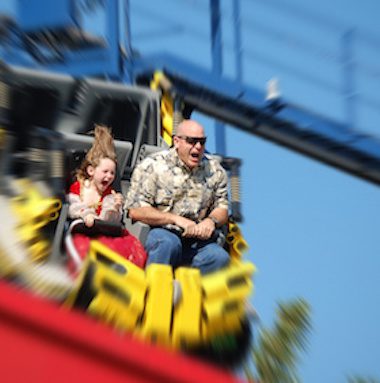
Who says scientific research isn’t fun?
Today we bring you some amusing research that just might amount to some serious help–if you have kidney stones, that is. New research published this month (October, 2016) in the Journal of the American Osteopathic Association has found that riding a rollercoaster may help to dislodge kidney stones. Seriously.
Before we dive too deep into this study, though, here is the 411 on kidney stones:
Everyone (for the most part) has two kidneys. They are located on either side of the lower part of the torso, below the ribs towards the back. They are shaped like kidney beans (hence their name), and they serve as filters for the body’s liquid waste. The kidneys pull liquid from the bloodstream and produce one to two quarts of urine every day. From each kidney, urine passes down a thin tube called a ureter into the bladder.
Kidney stones are mineral crystals that sometimes form inside the kidney. They can be tiny enough to pass right through the ureter without a problem, but they can also be big enough to cause significant pain, bleeding, kidney damage and infection. Their treatment depends on how big they are, their composition, and their location. Sometimes treatment is as simple as increasing water intake, taking pain medication and practicing patience. Sound waves are sometimes used to break up the stones into smaller particles so they can pass through the ureter, and in some cases surgery is necessary.
And apparently, some people have reported passing kidney stones after riding a rollercoaster or going bungee jumping.
These anecdotal reports, or individual stories, got Michigan researchers interested in studying the topic. Over the years they had repeatedly heard from patients who passed kidney stones after riding the Big Thunder Mountain Railroad roller coaster at Disney World in Orlando, Florida. Were these stories just coincidence or was there something about a roller coaster ride that helped dislodge kidney stones?
So, the researchers rigged up a model of a kidney into which they put some urine and three kidney stones of different sizes (you can see pictures of this here). Then, they placed this ersatz-kidney into a padded backpack and took it for 20 rides on that very same Disney roller coaster.
In case you are wondering about the other guests at the Park, the study authors noted the following:
Care was taken to protect and preserve the enjoyment of the other guests at the park. Before the park’s Guest Services consented to our research project, researchers agreed to abide by the park’s tenets of safety, show, courtesy, and efficiency.
Of the 20 rides taken, 8 were in the front cars and 12 were in the back of the roller coaster. Lo and behold, the stones did pass out of the kidney model, especially when the model was in the back of the train. The success rate in the back was nearly 70%, compared to a 16% success rate in the front cars of the ride.
Of course, now we have to put the breaks on this rollercoaster a bit and remind you that even the most amazing and well-designed kidney model can’t fill in for a real kidney in a real person with real kidney stones. So, even though these results are undoubtedly cool, they should be taken with caution. If you have kidney stones, please check with your doctor first before booking your ticket to Orlando.
Image Credit: Cheryl Casey/ Adobe Images

